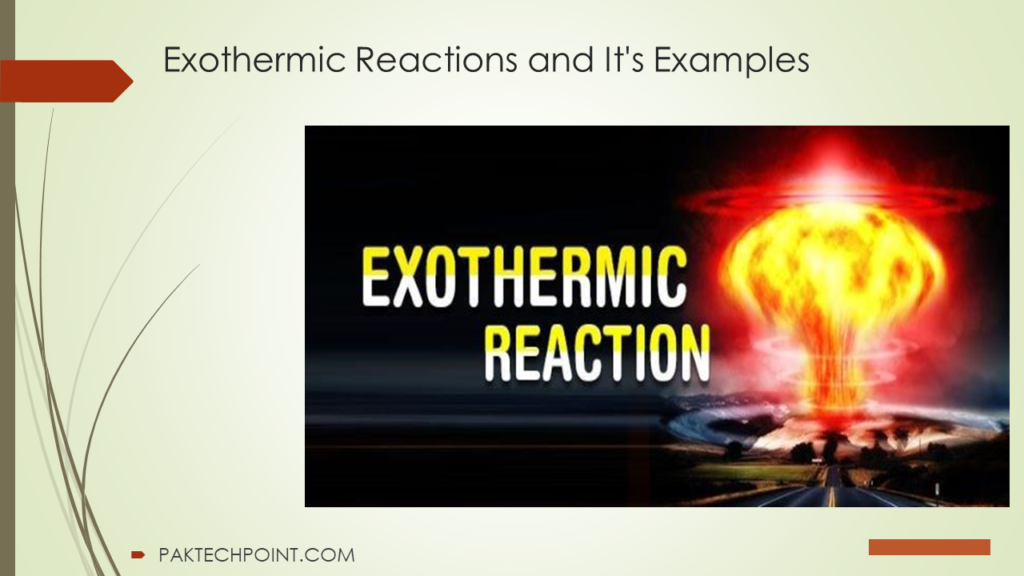An exothermic reaction is a type of chemical reaction that releases energy in the form of heat. In these reactions, the total energy of the products is lower than that of the reactants, resulting in the excess energy being released as heat into the surrounding environment. This heat release can often be observed as a temperature increase in the system.

What is Exothermic Reaction?
The term “exothermic” comes from the Greek words “exo,” meaning external or outwards, and “therme,” meaning heat. Exothermic reactions are the opposite of endothermic reactions, where energy is absorbed from the surroundings, causing a decrease in temperature.
Exothermic reactions typically involve the breaking of weaker bonds in the reactants and the formation of stronger bonds in the products. The energy difference between these bond formations is released as heat. This heat release is a manifestation of the law of conservation of energy, which states that energy cannot be created or destroyed, only transferred or converted from one form to another.
Chemical reactions are at the heart of countless natural processes and human-made technologies. Among these reactions, exothermic reactions stand out for their remarkable ability to generate heat. In this article, we’ll delve into the world of exothermic reactions, exploring their principles, examples, and the significance of the heat they release.
Table of Contents:
- Introduction to Exothermic Reactions
- Understanding Heat Release in Exothermic Reactions
- Examples of Exothermic Reactions
- Combustion Reactions
- Neutralization Reactions
- Oxidation Reactions
- Hydration Reactions
- Significance and Applications
- Safety Considerations in Exothermic Reactions
- Conclusion
Introduction to Exothermic Reactions:
In the realm of chemistry, exothermic reactions are a captivating phenomenon where the reactants transform into products while releasing heat. This release of energy is often observed in the form of temperature increase in the surrounding environment. Exothermic reactions are the antithesis of endothermic reactions, where energy is absorbed from the surroundings as the reaction proceeds.
Understanding Heat Release in Exothermic Reactions:
The heat released in exothermic reactions is a result of the formation of stronger chemical bonds in the products compared to the bonds in the reactants. This energy difference between the bonds is released in the form of thermal energy, which contributes to an increase in temperature. It’s important to note that the total energy of the reactants and products remains constant, in accordance with the law of conservation of energy.
Examples of Exothermic Reactions:
Let’s explore some common examples of exothermic reactions that occur in various contexts:
- Combustion Reactions: One of the most familiar exothermic reactions is combustion, where a fuel reacts with oxygen to release heat and produce products like carbon dioxide and water. The combustion of hydrocarbons, such as the burning of gasoline in a car engine or the ignition of wood in a campfire, are classic examples of exothermic reactions.
- Neutralization Reactions: When an acid reacts with a base, a neutralization reaction occurs. For instance, the reaction between hydrochloric acid (HCl) and sodium hydroxide (NaOH) yields water and table salt (NaCl). This process releases heat and is responsible for the warm sensation felt when consuming antacid tablets.
- Oxidation Reactions: Oxidation reactions involve the loss of electrons from a substance. The rusting of iron is an exothermic oxidation reaction, as it releases heat energy along with the characteristic reddish-brown iron oxide (rust) formation.
- Hydration Reactions: When certain substances react with water, they can release heat. An example is the hydration of quicklime (calcium oxide) when it reacts with water to form slaked lime (calcium hydroxide) and releases heat.
Significance and Applications:
Exothermic reactions have significant implications across various fields:
- Energy Production: The combustion of fossil fuels, which is essentially a series of exothermic reactions, powers our vehicles, heats our homes, and generates electricity in power plants.
- Metabolism: Exothermic reactions are crucial for the sustenance of life. In our bodies, the breakdown of food molecules releases energy, which is utilized by cells for various physiological processes.
- Chemical Synthesis: Exothermic reactions play a pivotal role in chemical synthesis. Industries use them to produce a wide range of products, including pharmaceuticals, plastics, and materials.
- Safety Flares: Controlled exothermic reactions are employed in safety flares, where they generate intense light and heat, making them useful for signaling and rescue operations.
Safety Considerations in Exothermic Reactions:
While exothermic reactions have diverse applications, they also pose potential hazards. The heat released can lead to temperature spikes and even explosions in certain conditions. Therefore, managing heat dissipation and controlling reaction rates are essential to ensure safety.
Conclusion:
Exothermic reactions are captivating examples of the intricate interplay between matter and energy. Their ability to generate heat not only fuels our everyday activities but also drives industrial processes and natural phenomena. By understanding the principles behind exothermic reactions, we gain insights into the fundamental aspects of chemistry and the dynamic world around us.